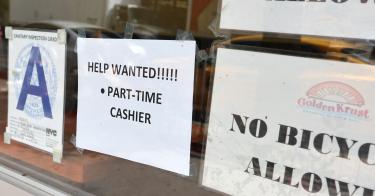The labor market increasingly resembles the imposing visage of the Wizard of Oz, with disappointment behind the curtain. Just look at the latest job numbers.
Recent data indicate the economy added about half as many jobs at the end of last year as previously estimated. No wonder many Americans view the economy unfavorably.
Each month, the Bureau of Labor Statistics compiles an estimate for the number of payrolls at businesses around the country, excluding farms. This is the widely reported jobs figure in the news each month, and it’s derived from a survey of about 119,000 companies and government agencies across 670,000 locations.
>>> Think Job Numbers Are Improving? Think Again
In the last quarter of 2023, these monthly job reports showed an increase of nonfarm payrolls by 637,000—robust growth, to be sure. But a much larger survey of businesses indicates this was a wild overestimation.
The BLS also publishes a Business Employment Dynamics, or BED, report each quarter, which comes from a much larger survey of 9.1 million private establishments. That’s more than 10 times the size of the survey used in the monthly job reports, so the BED has the law of large numbers on its side when debating accuracy.
This significantly larger survey showed only 344,000 jobs added in the final quarter of 2023, or roughly half the amount estimated by the monthly job reports. Contrary to the glowingly positive business news headlines each month, the labor market is not that strong after all.
In fairness, the nonfarm payroll and private sector employment figures from the two different BLS publications do not measure the same thing. Certain industries (government, railroads, agriculture, etc.) are included in one survey but not the other.
Nevertheless, these two figures track very closely over time, and the much larger dataset for the BED report is used to revise the monthly job figures later for greater accuracy. Those revisions will likely need to be substantial since the discrepancy between the two reports has become a pattern recently, meaning the divergence in the final quarter of 2023 is not merely a statistical fluke.
>>> Why We’re Adding Far Fewer Jobs Than the White House Claims
In the second quarter of last year, BED data indicated job growth was overestimated by about 489,000 in the monthly reports. The third quarter was even worse: The monthly job reports showed a cumulative gain of 640,000 nonfarm payrolls, but the BED data showed a loss of 192,000 private sector jobs. That’s a shockingly large difference of 832,000.
In short, the economy is adding nowhere near as many jobs as previously thought. But few people are bothering to look behind the curtain and find these important details. Instead, the initial estimates of blockbuster job growth get plenty of media attention each month, followed by silence when more comprehensive—but less impressive—numbers follow.
But these new figures help explain the disconnect between supposedly strong job creation and poor economic polling. Economists have been left scratching their heads, wondering how to square the circle of these contradictory indicators. The simple answer is that the labor market is rather anemic, and people are being honest about their feelings about the economy.
Dorothy is discovering that the Wizard is merely a facade.
This piece originally appeared in The Washington Times





